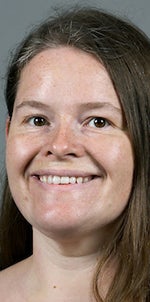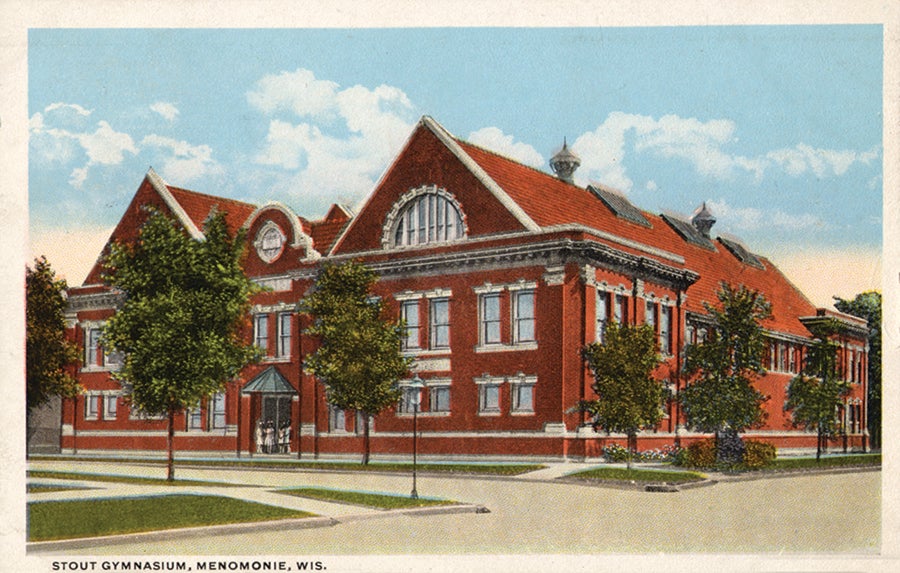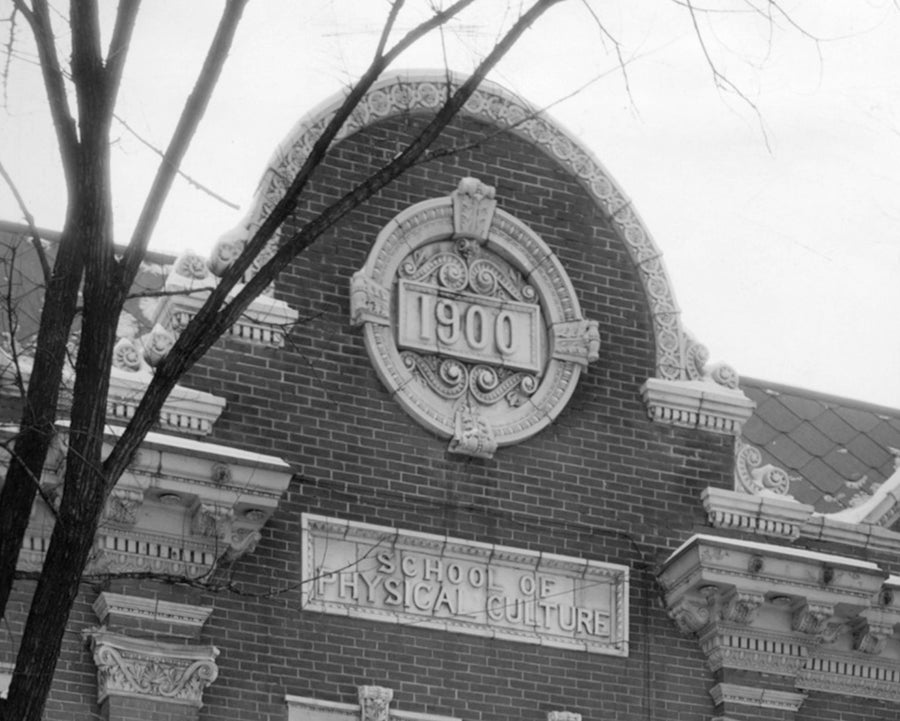A part of University of Wisconsin-Stout’s history will become a display outside the Rassbach Heritage Museum in Menomonie’s Wakanda Park.
The School of Physical Culture, which later became known as the Gymnasium/Natatorium, had a circular concrete medallion with the date of the building above the main entrance. The near six-foot across medallion will be placed outside between the museum and the adjoining Holtby Hall.
Tim Dotseth, of Menomonie, rescued the medallion from UW-Stout salvage, not knowing its history. He later saw a picture of the School of Physical Culture and recognized the architectural feature. He had the medallion in storage for many years.
The building, razed in 1964, was on Wilson Avenue south of Harvey Hall where the Communication Technologies building is located.
 For the Dunn County Historical Society’s annual meeting on Saturday, Nov. 17, UW-Stout Archivist Heather Stecklein will speak at Holtby Hall, 1820 Wakanda St. N.E., about the historical building and how it was used. She is scheduled to speak at 10 a.m. The presentation is free and open to the public. The annual meeting is from 9 to 11 a.m.
For the Dunn County Historical Society’s annual meeting on Saturday, Nov. 17, UW-Stout Archivist Heather Stecklein will speak at Holtby Hall, 1820 Wakanda St. N.E., about the historical building and how it was used. She is scheduled to speak at 10 a.m. The presentation is free and open to the public. The annual meeting is from 9 to 11 a.m.
The red brick building was built and donated to the community by Sen. James H. Stout, who in 1891 started Stout Manual Training School that became UW-Stout. He wanted the building to encourage physical fitness in youth. He announced the construction of the School of Physical Culture in November 1900.
“It was part of the whole progressive era to expose people to the finer things in life, so they will be better citizens,” Stecklein said. “It was a gift, so people could have fun, enjoy physical fitness and get together.”
The building cost $80,000, which is about $2.4 million now. It had two adjoining wings, a gymnasium and an indoor swimming pool called a natatorium. On the gymnasium side were club rooms and the school’s first bowling alley, she added. The swimming pool area offered Turkish baths.
In a May 1964 Minneapolis Sun Journal article, it was noted: “Stout’s purpose was to confer all youngsters of the community a chance to get proper exercise, free baths and learn how to swim.” It was to be available to all Menomonie children who could furnish soap and a towel, according to an Eau Claire Leader May 1964 article.
The building, 99 feet wide and 132 feet long, was three stories high with terra cotta accents and a tile roof. Several community groups, such as the Women’s Social Culture Club, made it their headquarters, according to the university history book “An Idea Comes of Age: UW-Stout, 1891-2016.”
Along with university use, the building also was used for physical education classes for Menomonie grade and high school students. Swimming lessons were given once a week, and there was an elevated track for runners.
A study done at Harvard University by Dr. D. A. Sargent produced figures to show that Menomonie youth were bigger, stronger and more agile than the national average, the Leader article noted. “The average Menomonie boy of 14 can lift with the muscles of his back 10 more than the Sargent boy; the boy of 15, 15.7 pounds; the boy of 16, 33.8 pounds; the boy of 17, 59.2 pounds; the boy of 18, 110 pounds.”

Many students experienced hot running showers for the first time when the building opened, Stecklein said. The building also served as an early student union for UW-Stout.
“The medallion is a visual reminder of a time and a building that was special for the Stout and the larger Menomonie community,” Stecklein said. “This was the final major gift from Sen. Stout to the Menomonie community.”
Frank Smoot, executive director of the Dunn County Historical Society, said it is unusual to find a medallion with a date. Museum signage will explain the artifact and where it came from.

Dotseth had a bricklayer create a vignette with brick around the medallion to make it look like it’s still on the building. “It puts it in a beautiful context,” Smoot said. “We’ll be proud to have it on display.”
Dotseth also designed the installation to be moveable, so it could theoretically travel to other sites.
“One of the things history does for us is to let us live for a little while in the lives of other people and visit the past,” Smoot said. “What it represents is a building where young people came from nearby schools to swim, where students could play billiards or take a Turkish bath for the first time. It speaks to the lives of people who came before us.”
It also shows that buildings that have been in communities for years won’t always be there, he added. “This medallion shows that big beautiful ‘permanent’ monuments like buildings can be gone from the face of the earth,” Smoot said.
UW-Stout is Wisconsin’s Polytechnic University, with a focus on applied learning, collaboration with business and industry, and career outcomes.
###
Photos
Heather Stecklein
A colorized postcard showed the School of Physical Culture that had a gym, indoor swimming pool and was built by Sen. James H. Stout for $80,000, which is nearly $2.4 million now. Stout wanted to encourage exercise and learning to swim.
The medallion on the School of Physical Culture building marked the date Sen. James H. Stout announced the building would be constructed.




